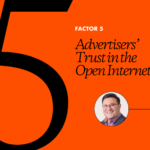The imminent demise of third-party cookies means it’s time for publishers to welcome back an old friend: contextual advertising.
Today, cookies and other tracking technologies allow marketers to target ads at individuals based on their online behavior — like which websites they’ve previously visited and what content they’ve looked at. But it’s increasingly clear that consumers resent being the targets of “surveillance capitalism”, where unseen marketers track their every online move.
Big tech companies are now taking action, with Apple enabling iOS users to opt-out of activity tracking and Google starting to phase out third-party cookies in its Chrome browser. With other tech companies making similar privacy-enhancing moves, advertisers are urgently seeking new ways to present consumers with ads that map to their interests.
One of those “new ways” is a decidedly old way. Contextual advertising — which old-timers will remember as the way online advertising used to work — serves ads that are based on the content of the page, rather than on an individual user’s browsing history. So ads for wedding gowns appear next to content about weddings, rather than following a presumed bride-to-be around whichever websites she happens to visit.
Not your grandmother’s contextual advertising
But a return to contextual advertising doesn’t mean turning the clock back to the 1990s. There have been huge technological advances since then, which means the new contextual advertising can be a lot smarter and more targeted than its late 20th-century equivalent.
In particular, advances in machine learning allow publishers and their advertisers to be much more granular about matching ads to relevant content. Whereas in the old days, any article about weddings might automatically be assumed to be an appropriate place to show an ad for wedding gowns, today’s contextual advertising engines can discern a lot more about the content, and make automated placement decisions based on multiple factors.
Those factors can range from device (only display the ad if the user is browsing the content on a desktop, for example) to brand safety (only display the ad if the content is free from ideological associations that could negatively impact consumers’ perception of the brand).
Why publishers make great partners for contextual advertisers
These factors create intriguing opportunities for publishers, who might otherwise find themselves losing contextual ad revenue to social platforms. After all, social platforms generate far more content and attract far more users than any individual publisher, so all else being equal, they should be the natural first port of call for advertisers.
But scale and reach aren’t everything. For a start, there’s the brand safety factor. The reluctance of social platforms to moderate user-generated content has led to a surge of online toxicity, hate speech, and disinformation. Advertisers are wary of having their ads appear alongside this kind of content — and rightly so, as most consumers say it would prompt them to stop purchasing from that brand. Publishers who keep toxicity out of their content have an advantage when it comes to attracting advertisers.
Secondly, there’s the question of quality. A lot of the attraction of contextual advertising for marketers comes from the ability to closely associate their brand with high-quality content. There’s also a lot of evidence that those associations pay off. A contextual targeting campaign run by perfume brand Carolina Herrera, for example, showed a 44% uplift in brand recall by being featured in close proximity to relevant holiday gift guides.
Reader comments can become high-quality inventory for contextual ads
It follows that the more quality content a publisher can produce, the more contextual advertising revenue they can attract. That’s where opening up comments sections and hosting reader communities can really help. With an active community, relevant ads can be shown against reader-contributed content as well as editorial content.
But doesn’t that create the same risks as social platforms: that ads might appear next to comments that are abusive, or which promote unacceptable ideological views? This is where sophisticated moderation comes into play. With a multi-layered moderation platform like OpenWebOS, publishers can extend the quality of their editorial content to the conversation in the comments section, creating reams of new, brand-safe inventory for contextual ads.
With OpenWebOS, for example, a combination of AI and human-powered moderation means publishers can easily detect and remove toxic comments before they’re published. What’s more, comments that score highly on our quality filters can be promoted or pinned to the top of conversations, where they’re seen by more people. Those comments then become ideal real estate for contextually-relevant ads.
OpenWeb presents contextually-relevant ads to users participating in real-time conversations.
Lastly, using OpenWeb to power online conversations has a positive impact on views of editorial content, too. Readers who sign up to comment with OpenWeb view 200% more pages, stay for 35% longer, and are 450% more likely to return. That means more views for contextual ads placed on editorial content — and thus even more appeal for advertisers.
Explore the new world of contextual advertising with OpenWeb
With the end in sight for behavioral targeting as we know it, it’s time for publishers to give contextual targeting a try. Find out more about maximizing contextual advertising effectiveness with OpenWeb.


